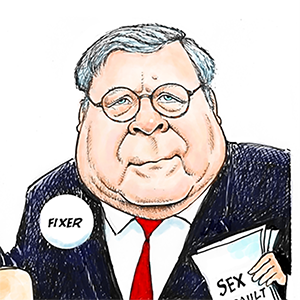Fashion Daily
/Home & Leisure
How to rock a baseball cap
MINNEAPOLIS -- I grew up in a generation in which wearing a baseball cap in even semiformal settings was as rude as attending a funeral in Bermuda shorts.
That’s no longer the case. Caps are making a splash at office meetings, red carpets and cocktail parties. They’re even accepted at the White House.
“The look of the MAGA Republican is ...Read more
7 tips to save for a home on a tight budget
For Americans living paycheck to paycheck, there’s little room to make progress on goals like getting a mortgage and becoming a homeowner.
If you’re set on buying a home this year but can’t increase your income, ...Read more
Answer Angel: Swimsuit shopping
Dear Answer Angel Ellen: Are there any modest swimsuits made for women with flat derrieres? I find it a challenge to find one.
--Anna C.
Dear Anna: The trend in swimwear is definitely going in the opposite direction of “modest.” A trip to almost any beach or pool will illustrate that swimsuit styles are ...Read more
Know your rights as an LGBTQ+ homebuyer
If you’re an LGBTQ+ homebuyer, you may be unsure of your current legal status. Recent federal policy changes have eroded some equal housing protections for LGBTQ+ Americans, leaving the most stringent laws at the state level.
Meanwhile, LGBTQ+ people are still less likely to own homes than straight, cisgendered people. The homeownership ...Read more
From dozens of antique shops, this street is down to one
SAN DIEGO -- Ask Dave McPheeters, 75, to introduce himself, and this is what he says.
“I am the owner of Zac’s Attic. I am the last man standing on Adams Avenue, the original Antique Row.” A pause, a breath. “So I’m kind of a dinosaur in this business.” A laugh.
The word dinosaur comes up more than once. The second time, he uses it...Read more
Answer Angel: Searching for scarves
Dear Answer Angel Ellen: Well, I did not realize scarves were totally out of fashion until I started looking for scarves for a friend undergoing cancer treatment, and you know what that leads to. At any rate, no scarves in the stores in my immediate area, although I must admit my shopping options are limited to the usual big-...Read more
A Charles Lindbergh boom and bust at 'Antiques Roadshow' stop in St. Louis
ST. LOUIS -- In 1926, George Allen Kelley was a teenager fascinated by the pilots and their aircraft at Lambert Flying Field in St. Louis.
He would hang around the field, hoping to catch a conversation or see something exciting. The big man in town causing much of the excitement was Charles Lindbergh, of course. He was working on the aircraft ...Read more
Answer Angel: Worse than capri pants?
Dear Answer Angel Ellen: There’s actually a worse style than capri pants: cropped pants with wide legs. Wide-leg cropped pants look like something you’d wear in a folk group that dances to sea shanties.
I tried to find dress pants for summer from my usual online stores. Almost all styles were capri-length (ending mid-calf...Read more
An enormous pouf of tulle graces Cannes
Apparently actor Qianhui Wan did not get the new dress code memo from the Cannes Film Festival, which prohibits “voluminous outfits, in particular those with a large train, that hinder the proper flow of traffic of guests and complicate ...Read more
Do all grocery store purchases earn grocery cash back rewards?
The cash back earned buying groceries with your rewards credit card can make for a helpful stash to cover your next purchase, travel plans or put some money back into your account. But you might be surprised that errands to some stores won’t earn boosted grocery rewards, even if you’re buying food.
In part, it depends on which credit card ...Read more
7 best ways to send money
Sending money to someone else has never been easier, thanks to peer-to-peer (P2P) payments. With just a few taps on your smartphone, you can send or receive money instantly. These tools are especially ...Read more
Answer Angel: Tuck trend
Dear Answer Angel Ellen: My question: What's with the tucking in of the front of your shirt, but leaving the back flapping out?? That looks ridiculous!
--Linda M.
Dear Linda: This is a look popularized by Tan France on the Netflix show "Queer Eye." And you’ve described it well — ...Read more
Mindy Kaling wears perfect spring dress to Gold Gala
If spring were a dress, it would look like this.
Mindy Kaling, at the Gold Gala in Los Angeles last weekend, wore a strapless Anita Dongre gown that seemed to have flowers blooming all over it. Such a simple silhouette, but such a beautiful effect; it’s the kind of dress that makes its own light.
First Mexican hair care line at ULTA Beauty
FRESNO, Calif. -- Pilar García Bonilla had a dream and desire to help women like her who might be self-conscious of their curly hair and don’t feel comfortable being themselves because of their curls.
García Bonilla said she grew up thinking that straight hair was beautiful and sophisticated while curly hair was messy. She said something ...Read more
Answer Angel: Hostess gifts
Dear Answer Angel Ellen: I am going on a trip overseas and visiting with our former neighbors who moved there.
I haven’t seen them for some years and feel obligated to bring some sort of “host/hostess” gift from the U.S. But we will be traveling so it can’t be perishable or take up much space in my suitcase. ...Read more
Answer Angel: The Met Gala
Dear Answer Angel Ellen: Can you please explain to me what is the big deal about the Met Gala? What am I missing here?
--James. J.
Dear James: What? You mean you don’t enjoy watching rich, famous people in amazingly expensive one-of-a-kind outfits (many of whom got them for free) posing for photos...Read more
Diana Ross dazzles with a sparkly gown (and 18-foot train) at Met Gala
The Met Gala — the very glam annual fundraiser for The Metropolitan Museum of Art’s Costume Institute — took place this month, with a theme of “Superfine: Tailoring Black Style,” celebrating the history and influence of the Black dandy.
And as you can see, Diana Ross went with an understated and low-key look: just your everyday 18-...Read more
Michelle Pfeiffer wears sleek suit to Hollywood Walk of Fame ceremony
The Hollywood Walk of Fame has been around for more than 60 years, so it’s a mystery to me why they took forever to honor the great Michelle Pfeiffer, whose long career epitomizes both remarkable talent and movie-star glamour. (If you haven’t seen Pfeiffer in “homeandleisure/fashiondaily/fashiondailynews/s-3706078">Read more
Buy now, pay later can help or hurt your credit score — here’s why
Buy now, pay later (BNPL) has shaken up the credit game with its low-or-no-interest payment plans for large purchases. In fact, Bankrate’s 2024 Buy Now, Pay Later Survey reported that nearly 2 in 5 ...Read more
‘The Gilded Age’ will return to HBO in June — and so will the hats
Here’s some good news, should you be in need of it: Julian Fellowes’ very gilded HBO series “The Gilded Age,” set in moneyed 1880s Manhattan, will be back for its third season in June, streaming on Max.
And if you’re wondering whether the hats...Read more





